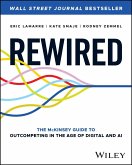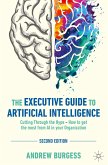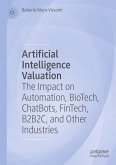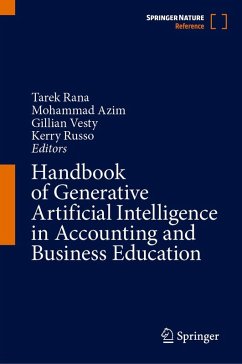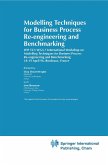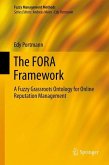Case Studies in Digital Transformation
Integration of Digital Technologies to Enhance Asset Management Processes
Herausgegeben:Crespo Márquez, Adolfo; Seecharan, Turuna; Abdul-Nour, Georges; Amadi-Echendu, Joe; Lee, Jay
Case Studies in Digital Transformation
Integration of Digital Technologies to Enhance Asset Management Processes
Herausgegeben:Crespo Márquez, Adolfo; Seecharan, Turuna; Abdul-Nour, Georges; Amadi-Echendu, Joe; Lee, Jay
- Gebundenes Buch
- Merkliste
- Auf die Merkliste
- Bewerten Bewerten
- Teilen
- Produkt teilen
- Produkterinnerung
- Produkterinnerung
This book is exploration into the forefront of digital evolution, presenting a compelling array of real-world case studies that underscore the transformative impact of emerging processes and services on asset management. The book goes beyond theoretical frameworks, offering a dynamic narrative that reveals how organizations across industries are strategically integrating cutting-edge technologies into their asset management practices.
With a keen focus on innovation, the book examines the key role of IoT, artificial intelligence, and other groundbreaking technologies in reshaping…mehr
Andere Kunden interessierten sich auch für
![Rewired Rewired]() Eric LamarreRewired31,99 €
Eric LamarreRewired31,99 €![The Executive Guide to Artificial Intelligence The Executive Guide to Artificial Intelligence]() Andrew BurgessThe Executive Guide to Artificial Intelligence29,99 €
Andrew BurgessThe Executive Guide to Artificial Intelligence29,99 €![Artificial Intelligence Valuation Artificial Intelligence Valuation]() Roberto Moro-ViscontiArtificial Intelligence Valuation119,99 €
Roberto Moro-ViscontiArtificial Intelligence Valuation119,99 €![New Business Organizational Models for Governing in Times of Change New Business Organizational Models for Governing in Times of Change]() Angelo RosaNew Business Organizational Models for Governing in Times of Change64,99 €
Angelo RosaNew Business Organizational Models for Governing in Times of Change64,99 €![Handbook of Generative Artificial Intelligence in Accounting and Business Education Handbook of Generative Artificial Intelligence in Accounting and Business Education]() Handbook of Generative Artificial Intelligence in Accounting and Business Education490,99 €
Handbook of Generative Artificial Intelligence in Accounting and Business Education490,99 €![Modelling Techniques for Business Process Re-engineering and Benchmarking Modelling Techniques for Business Process Re-engineering and Benchmarking]() Guy Doumeingts / J. Browne (Hgg.)Modelling Techniques for Business Process Re-engineering and Benchmarking153,99 €
Guy Doumeingts / J. Browne (Hgg.)Modelling Techniques for Business Process Re-engineering and Benchmarking153,99 €![The FORA Framework The FORA Framework]() Edy PortmannThe FORA Framework76,99 €
Edy PortmannThe FORA Framework76,99 €-
-
-
This book is exploration into the forefront of digital evolution, presenting a compelling array of real-world case studies that underscore the transformative impact of emerging processes and services on asset management. The book goes beyond theoretical frameworks, offering a dynamic narrative that reveals how organizations across industries are strategically integrating cutting-edge technologies into their asset management practices.
With a keen focus on innovation, the book examines the key role of IoT, artificial intelligence, and other groundbreaking technologies in reshaping traditional asset management paradigms. Readers will gain valuable insights into success stories, challenges faced, and the strategic considerations that underpin these transformative journeys. The book's coverage highlights the tangible benefits of digital solutions, such as enhanced efficiency, heightened resilience, and strategic advantage.
With a keen focus on innovation, the book examines the key role of IoT, artificial intelligence, and other groundbreaking technologies in reshaping traditional asset management paradigms. Readers will gain valuable insights into success stories, challenges faced, and the strategic considerations that underpin these transformative journeys. The book's coverage highlights the tangible benefits of digital solutions, such as enhanced efficiency, heightened resilience, and strategic advantage.
Produktdetails
- Produktdetails
- Engineering Asset Management Review 4
- Verlag: Springer / Springer Nature Switzerland / Springer, Berlin
- Artikelnr. des Verlages: 89294260, 978-3-032-05591-0
- Seitenzahl: 383
- Erscheinungstermin: 19. Januar 2026
- Englisch
- Abmessung: 235mm x 155mm
- ISBN-13: 9783032055910
- ISBN-10: 3032055911
- Artikelnr.: 75136379
- Herstellerkennzeichnung
- Springer-Verlag GmbH
- Tiergartenstr. 17
- 69121 Heidelberg
- ProductSafety@springernature.com
- Engineering Asset Management Review 4
- Verlag: Springer / Springer Nature Switzerland / Springer, Berlin
- Artikelnr. des Verlages: 89294260, 978-3-032-05591-0
- Seitenzahl: 383
- Erscheinungstermin: 19. Januar 2026
- Englisch
- Abmessung: 235mm x 155mm
- ISBN-13: 9783032055910
- ISBN-10: 3032055911
- Artikelnr.: 75136379
- Herstellerkennzeichnung
- Springer-Verlag GmbH
- Tiergartenstr. 17
- 69121 Heidelberg
- ProductSafety@springernature.com
Adolfo Crespo Márquez is Full Professor at the University of Seville with over 25 years of experience in asset and maintenance management. He received the Spanish Maintenance Award (AEM, 2020) and appears in Stanford University’s list of top scientists (2022). Author of The Maintenance Management Framework (Springer, 2007), his model has been widely applied in industry. He is Editor-in-Chief of the Engineering Asset Management Review series, Fellow and Director of ISEAM, and President of INGEMAN. His research focuses on digital transformation, reliability, and strategic asset management in industrial and infrastructure contexts. Turuna Seecharan is an Associate Professor in the Department of Mechanical and Industrial Engineering at the University of Minnesota Duluth. She is a licensed Professional Engineer with the Professional Engineers of Ontario and a board member of the International Society of Engineering Asset Management. Her research interests are Gamification and the role of Human Factors in Asset Management. Dr. Georges Abdul-Nour is an Emeritus Professor of Industrial engineering, Université du Québec, Canada. He completed his PhD at Texas Tech University. He authored and co-authored more than 450 books and chapters, refereed papers, and technical reports. His research interest is in Intelligent Asset Management, Systems Resilience, and Reliability, Lean Intelligent Manufacturing and Six Sigma. He is member of the Editorial Board of International Journal of Production Research, and Director on the Board of International Society of Engineering Asset Management. He is an Elected Member of the Academy of Industrial Engineering of Texas Tech. He is a Fellow of ISEAM. Joe Amadi-Echendu is Emeritus Professor of Engineering and Technology Management at the University of Pretoria, South Africa. Professor Amadi-Echendu is the founding Editor-in-Chief of EAMR Series. He is the sole author of a textbook, lead author of 3 books, and co-editor of another 7 books all published by Springer. Joe is registered as a chartered professional engineer in the UK and South Africa and currently serves as the Chair of Board of Directors of the International Society of Engineering Asset Management. Jay Lee is Clark Distinguished Chair Professor and Director of the Industrial AI Center at the University of Maryland, College Park. He is internationally recognized for his pioneering contributions to industrial AI and intelligent maintenance systems. Formerly, he was Ohio Eminent Scholar, L.W. Scott Alter Chair, and University Distinguished Professor at the University of Cincinnati. Dr. Lee founded the NSF I/UCRC on Intelligent Maintenance Systems and has led major collaborations with global industry partners. His leadership has had significant economic and technological impact. As Founding Director of the Industrial AI Center, he remains at the forefront of advancing smart manufacturing and predictive analytics in asset management.
Part 1: Digital Transformation and Value Creation in Asset Management.- Chapter 1. New Value Perspective for Value Creation with Social Priceless Assets Through Digital Transformations.- Chapter 2. A Roadmap for Digital Transformation in the Architecture, Engineering, Construction, and Operations Industry: A Survey and Industry Analysis.- Chapter 3. Resilience and Life Cycle Management of Critical Urban Asset Systems in Face of Emerging Threats.- Chapter 4. The Impact of Blockchain Technology for Sustainable Asset Maintenance in Telecoms Domain in Emerging Markets.- Part 2. Data-Driven Asset Management and IoT Applications.- Chapter 5. From Data to Decisions: Empowering Pipeline Operators with Actionable Insights.- Chapter 6. Industrial IoT and 3D Digital Twin for Real-Time Evergreening of Engineering Assets Subjected to Corrosion Under Insulation.- Chapter 7. Optimization of Maintenance Management through Digital Integration: AMORMS Audit and SAP Implementation in a Cosmetics Manufacturing Company.- Part 3. Case Studies and Implementation Frameworks.- Chapter 8. Implementation of an asset management plan according to iso 55001 at the Colmito power generation plant Chile.- Chapter 9. BIM-Powered Asset Management Solutions Digitalizing Building Maintenance.- Chapter 10. Assessment of the Technical and Functional Performance of Public Buildings.- Part 4. Specialized Topics and Emerging Applications.- Chapter 11. Infodynamic Analysis of Damage Detection on Bridges.- Chapter 12. Failure Detection in Secondary Cryogenic Pumps Through ML Techniques in the Context of Industry 4.0.- Chapter 13. Statistical Modelling of Digital Capture Data of Water Assets: Principal Components and Cluster Analyses of Water Tanks in Brazilian Municipalities.- Chapter 14. The Synergy Between Lean Philosophy and Value Engineering for New Product Development.- Part 5. Business and Organizational Perspectives.- Chapter 15. An Asset Management Approach to Beekeeping for Enhanced Pollination and Agriculture Sustainability.- Chapter 16. Overview of the Use of Data Assets in the Context of Portuguese Companies: Comparison Between Micro, SMEs, and Large Companies.
Part 1: Digital Transformation and Value Creation in Asset Management.- Chapter 1. New Value Perspective for Value Creation with Social Priceless Assets Through Digital Transformations.- Chapter 2. A Roadmap for Digital Transformation in the Architecture, Engineering, Construction, and Operations Industry: A Survey and Industry Analysis.- Chapter 3. Resilience and Life Cycle Management of Critical Urban Asset Systems in Face of Emerging Threats.- Chapter 4. The Impact of Blockchain Technology for Sustainable Asset Maintenance in Telecoms Domain in Emerging Markets.- Part 2. Data-Driven Asset Management and IoT Applications.- Chapter 5. From Data to Decisions: Empowering Pipeline Operators with Actionable Insights.- Chapter 6. Industrial IoT and 3D Digital Twin for Real-Time Evergreening of Engineering Assets Subjected to Corrosion Under Insulation.- Chapter 7. Optimization of Maintenance Management through Digital Integration: AMORMS Audit and SAP Implementation in a Cosmetics Manufacturing Company.- Part 3. Case Studies and Implementation Frameworks.- Chapter 8. Implementation of an asset management plan according to iso 55001 at the Colmito power generation plant Chile.- Chapter 9. BIM-Powered Asset Management Solutions Digitalizing Building Maintenance.- Chapter 10. Assessment of the Technical and Functional Performance of Public Buildings.- Part 4. Specialized Topics and Emerging Applications.- Chapter 11. Infodynamic Analysis of Damage Detection on Bridges.- Chapter 12. Failure Detection in Secondary Cryogenic Pumps Through ML Techniques in the Context of Industry 4.0.- Chapter 13. Statistical Modelling of Digital Capture Data of Water Assets: Principal Components and Cluster Analyses of Water Tanks in Brazilian Municipalities.- Chapter 14. The Synergy Between Lean Philosophy and Value Engineering for New Product Development.- Part 5. Business and Organizational Perspectives.- Chapter 15. An Asset Management Approach to Beekeeping for Enhanced Pollination and Agriculture Sustainability.- Chapter 16. Overview of the Use of Data Assets in the Context of Portuguese Companies: Comparison Between Micro, SMEs, and Large Companies.


